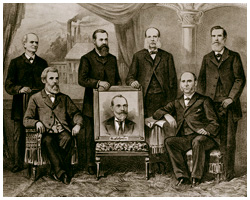
The story of Labor Day remains incomplete without an
introduction to the Knights of Labor. Not only did they initiate
Labor Day as a civic event, it had proved itself to be the first labor
association strong enough to challenge industry on its own ground.
And it was with them the future
of American labor in the 1880s appeared to lie.
Starting with nine inconspicuous tailors in Philadelphia on December 9,
1869 , the K of L sought to promote a unionism to embrace all workers,
skilled and unskilled, in a single labor organization. They were
convinced that trade unionism, as it had been known, had to give way to
labor organization on a much broader basis. The founder leader of the
organization, Stephens was a tailor by profession and was a staunch
believer in the principle of the Brotherhood of Man. The organization
took some years to take off. It was only after the second assembly in
1872 the pace of its growth sped up. In 1874 the first assembly was
established beyond the area of its origin. It was in New York. The
groups joining the assembly entailed workers of distinct crafts e.g.
garment cutters, ship carpenters, shawl weavers, masons, machinists and
blacksmiths, house carpenters, tin plate and iron workers, stone cutters
and gold beaters. Gradually they were joined in by miners, railway
workers and steel workers in increasing numbers. Whenever there were not
enough members of a single trade to form a trade assembly, especially in
small towns and rural areas, the mixed assembly became a general
catchall. Eventually, the mixed assemblies outnumbered the trade
assemblies and with their inclusion of unskilled workers the Knights
gained a distinctive character.
The Order became truly national organization in a sense never attained
by its predecessors, and it further differed from them in that the
membership remained on an individual basis rather than through
affiliated unions.
Thus membership became open to all wage earners and to all former wage
earners, with the exception of doctors, bankers and traders and
manufacturers of liquor. A prospective member was invited to participate
in a meeting without being told what it was. The eligibility for
initiation was only through the successful completion of an interview.
The ritual was passed by word of mouth keeping everything a secret to
the outsiders.
The K of L constitution set forth many of the
traditional demands of organized labor and also added some new goals. It
called for the 8-hour day, the establishment of cooperatives, the
reservation of public lands for actual settlers and a fiat
currency, prohibition of child labor, equal pay for the sexes,
establishment of the bureau of labor statistics, abolition of contract
system for prison labor, adoption of a graduated income tax, and
government ownership of the railways and telegraphs.
They stressed
organization, education, and political agitation as the best means to
build a new society. They insisted that the existing economic system
could only be changed peaceably, and this often led them to oppose
strikes.
But, despite their progressive outlook their philosophy did not keep the
powerful skilled workers and the militant labor leaders allegiant to the
Order. And soon the rift surfaced. The members of the traditional trade
unions became increasingly unwilling to link their fortunes with the
weaker sections e.g. unskilled ones. The need for 'new unionism'
evolved. And eventually the K of L ceased to exist.
Looking for Something? Search Google :